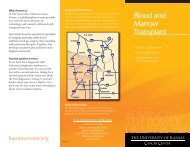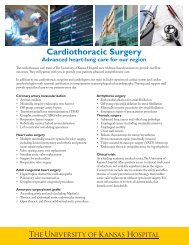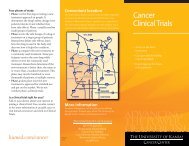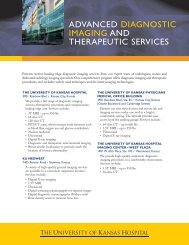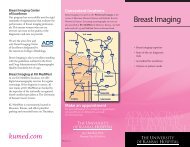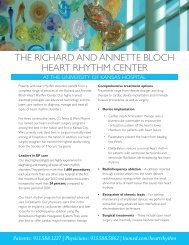Medical Advancements at<strong>The</strong> <strong>University</strong> <strong>of</strong> Kansas Hospitaltechniques have shown promise, theyare <strong>of</strong>ten lengthy, require retreatmentand include complications. Surgery– primarily the maze procedure – hasgreat potential, but many physiciansare reluctant to take this step when thecondition is medically manageable.Hybrid ablation and structuralcorrection are two new approachesthat show great promise.Structural: Amplatzer cardiacplug and LARIAT® deviceMore than 90 percent <strong>of</strong> clots thatcause strokes in patients with nonvalvular atrial fibrillation arise inthe left atrial appendage, or LAA, aubiquitous embryologic remnant.Blood thinners are the mainstay<strong>of</strong> therapy for stroke prophylaxis.However, a significant portion <strong>of</strong>patients who might benefit from bloodthinners have contraindications dueto systemic bleeding, frequent fallsand other potential problems. Somepatients without contraindications mayexperience stroke despite the use <strong>of</strong>blood thinners. Patients need treatmentstrategies that can potentially eliminatethe LAA from systemic circulation. <strong>The</strong>Amplatzer Cardiac Plug, or ACP, andthe LARIAT are devices used to occludethe LAA.<strong>The</strong> <strong>University</strong> <strong>of</strong> Kansas Hospital isone <strong>of</strong> 70 sites participating in a clinicaltrial for stroke prevention with the ACP,and the only location in the region.This is a two-to-one randomized trial <strong>of</strong>the ACP vs. anticoagulation studyingoverall success, safety and efficacy. Itinvolves inserting a catheter through thefemoral vein, performing a transseptalpuncture and placing the device withinthe LAA. This seals <strong>of</strong>f the LAA toblood flow and prevents clot formation.Scar tissue then forms to permanentlyseal <strong>of</strong>f the LAA where most AF-relatedembolic strokes originate.<strong>The</strong> LARIAT suture delivery deviceis a catheter-based system that uses asnare to close <strong>of</strong>f the LAA. It has beenshown to safely and reliably suture theLAA shut using combined endocardialand epicardial access. Like the ACP, theLARIAT involves inserting a catheterthrough the femoral vein, performinga transseptal puncture and placinga wire with a magnetic tip into theLAA. A catheter is also placed into thepericardium and another magnet-tippedwire is then placed through the catheteron the outside <strong>of</strong> the heart. <strong>The</strong> magnetsfind each other. A lasso or LARIAT isthen placed over the wire ensnaringthe LAA. An embedded suture then iscinched down over the LAA, closingit <strong>of</strong>f.In both <strong>of</strong> these procedures, the aim isto prevent strokes, and eliminate theneed for long-term anticoagulant drugsin patients with atrial fibrillation.Hybrid ablationFor patients with persistent orlongstanding AF, ablation therapydoesn’t yield similar results as itdoes in those with paroxysmal AF.A new hybrid technique, combininga percutaneous electrophysiologicalapproach with a mini-maze procedureholds great potential for bringing thebest <strong>of</strong> all these treatments together.With this approach, the surgeonperforms anatomically guided epicardialablation using continuous lines andcreates a left atrial box lesion throughminimally invasive right chest access.<strong>The</strong> electrophysiologist employselectrically guided mapping to performendocardial ablation, to identify gaps inthe epicardial ablation lesion sets and toabate triggers and re-entry arrhythmias.<strong>The</strong> benefits <strong>of</strong> hybrid ablation include• Shorter time for each procedure• Complete lesion set: epicardial +endocardial• Epicardial occlusion <strong>of</strong> LAA, if desired• Fewer complications• Improved outcomesThis approach is currently under studyfor a clinical trial later this year.To consult with a physician at theCenter for Advanced Heart Care,call 913-588-5862 or toll free877-588-5862. Find moreinformation at kumed.com/heart.Dr. Tadros is director <strong>of</strong> interventional services and Lynn H. Kindred, MD, Cardiovascular Catheterization Laboratories at<strong>The</strong> <strong>University</strong> <strong>of</strong> Kansas Hospital’s Center for Advanced Heart Care, a member <strong>of</strong> the Cardiovascular Research Institute andassistant pr<strong>of</strong>essor at the <strong>University</strong> <strong>of</strong> Kansas Medical Center.5Dr. Zorn is the surgical director <strong>of</strong> <strong>The</strong> <strong>University</strong> <strong>of</strong> Kansas Hospital’s Center for Advanced Heart Care Valve Center. Recentresearch includes “Role <strong>of</strong> hybrid endovascular suite in improving outcomes <strong>of</strong> surgical ligation <strong>of</strong> coronary artery fistula.” Steffen,Kelly; Zorn III, George Trip; Tadros, Peter; Gupta, Kamal. <strong>The</strong> Journal <strong>of</strong> Invasive Cardiology 2012, 24(1), E10-12.KUMedInnovationsSummer2013_X.indd 56/13/13 10:09 AM
<strong>Interventional</strong> Neurosurgery:Advances <strong>Of</strong>fer Safe AlternativesPaul Camarata, MD, Chair, NeurosurgeryKoji Ebersole, MD, Director, Endovascular NeurosurgeryDouglas Girod, MD, OtolaryngologyinnovationsRecent advancesin technology andprocedures forusing catheterbasedand other interventional methods inneurosurgery are providing faster, safer, moreeffective treatments. We now have moreoptions for treating certain aneurysms, strokesand other head and neck issues that may havebeen untreatable in the past. <strong>The</strong> best news,however, is that we have only just begun.<strong>The</strong> most common interventionalaneurysm repair attempts to “pack” theaneurysm, causing thrombosis that willreduce the pressure and inhibit rupture.<strong>The</strong> primary method is coiling: platinumwires delivered via catheter to fill theaneurysm as tightly as possible, leadingto clot formation and occlusion.This much less invasive technique workedbest initially on spherical aneurysms withsmall necks. Over time, we found betterways to fit the coils more tightly into oddlyshaped aneurysms and to more effectivelybridge the neck. We also have seen thedevelopment <strong>of</strong> balloons that inflatetemporarily in the vessel, giving us moretime to make the coils fit complex shapes.And new coiling materials and liquids areable to increase the density <strong>of</strong> the packing.Still, the recurrence rate with coiling canaverage around 15 percent.Each innovation in materials, proceduresand skill development holds the promise<strong>of</strong> even broader application, giving us hopefor continuing to dramatically increasethe survivability <strong>of</strong> these potentiallydevastating events. This is a review <strong>of</strong> some<strong>of</strong> the latest developments in:• Treatment <strong>of</strong> cerebral aneurysms• Mechanical thrombectomy• Other interventions in neurosurgeryand otolaryngologyEmbolization device virtually erasesevidence <strong>of</strong> aneurysmAbout 1 or 2 percent <strong>of</strong> the U.S.population likely has a cerebral aneurysm.That equates roughly to the entirepopulation <strong>of</strong> the state <strong>of</strong> Kansas orMissouri. Yet only a very small percentage– about 30,000 <strong>of</strong> these aneurysms – willrupture each year. Smaller aneurysms are<strong>of</strong>ten better left alone; depending on thepatient’s risk characteristics, they are notlikely to rupture. But larger, more complexaneurysms <strong>of</strong>ten warrant treatment.Open surgical treatment <strong>of</strong> aneurysm,most recently using surgical clips, has beenavailable for more than 60 years and hasproven very successful, with low recurrencerates. But interventional procedures havesurpassed open surgery by two or threeto one over the past 25 years, due to theirattractive minimally invasive nature.<strong>The</strong> new Pipeline embolization devicerelies on a completely different thoughtprocess. Instead <strong>of</strong> packing the aneurysmand allowing the blood flow to continuestressing that spot with each pulsation,the Pipeline relies on diverting blood flowaway from the weakened vessel wall.Unlike the usual stent, which is designed tobe as light as possible, the Pipeline is like adense hose, consisting <strong>of</strong> 48 braided wiresmade <strong>of</strong> 75 percent cobalt chromium and25 percent platinum tungsten. It is placedinside the vessel from which the aneurysmarises, providing supportive scaffoldingacross the aneurysm neck and keepingthe blood flow in a favored vector down6KUMedInnovationsSummer2013_X.indd 66/13/13 10:09 AM



